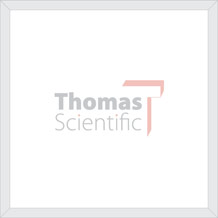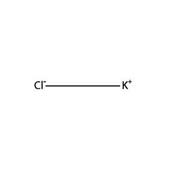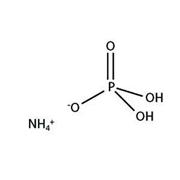bioWORLD, 1 kg, Chemicals
-
Tryptic Soy Agar
bioWORLDUsed for the isolation and cultivation of nonfastidious and fastidious microorganisms Can be prepared with or without blood or enrichments pH: 7.3 Working Concentration: 40 g/L Dehydrated Appearance: light beige, homogeneous powder Prepared Appearance: Plain – light…
-
Agar, Phytoagar
bioWORLDFree of extra salts that are often present in many agar preparations and affect plant growth. Gel Strength: 950 g/cm 2 Working Concentration: 5−7 g/L Gelling Temperature: 38°C Moisture: 10.92% Ash Content: 1.2% Swelling Index: 9.0 mL Water Absorption:…
-
Potassium hydroxide
bioWORLDBuffer reagent Used for making potassium soap, shampoo, potassium permanganate etc. Used in dye, drugs manufacture, galvanization, carving, lithography etc. A basic reagent used for alkaline lysis and pH purposes. Specifications Reagent Grade Moisture: 10-15% …
-
Gellan Gum Powder
bioWORLDSynonym: Culturegel™ Type I: Biotech Grade Plant tissue culture tested Working Concentration: 1.5-2.5 g/L Gel Strength: 800 g/cm 2 Partially soluble in water
-
R2B Broth
bioWORLDLow nutrient medium for plate detection of heterotropic bacteria in water Low concentrations of carbon and energy sources enhance the recovery of stressed bacteria Ideal for membrane filtration methods pH: 7.2 Working Concentration: 3.6 g/L Dehydrated Appearance: light…
-
EDTA, ferric sodium salt
bioWORLDAn eliminator of enzyme catalyzed reaction inhibition. Plant culture tested. Supports or facilitates plant growth and/or shoot proliferation in two or more plant tissue cultures. Appearance: Yellow to Brown Crystalline Powder Boiling Point: 614.2°C Density: 7.87 g/cm3 at…
-
Ammonium Acetate
bioWORLDBeing the salt of a weak acid and a weak base, ammonium acetate has a number of distinctive properties. It is occasionally employed as a biodegradable de-icing agent. It is often used with acetic acid to create a buffer solution, one that can be thermally decomposed to non-ionic products. It is…
-
Potassium Carbonate, anhydrous
bioWORLDSynonyms: Carbonate of potash; Dipotassium carbonate; Dipotassium salt; Pearl ash; Potash; Salt of tartar; Salt of wormwood A potassium salt for deproteinization and as a drying agent Common biochemical reagent used in soap, glass, and china production and as a drying agent and…
-
Boric acid (Molecular Biology Grade)
bioWORLDA commonly used molecular biology reagent and also used in electrophoresis buffers. pKa (@ 20°C): 9.24 Molecular Biology Grade (also available in Proteomics Grade) Chloride: <.001% Phosphate: <0.001% Sulfate: <0.01% Calcium: <0.005% Heavy metals…
-
bioPLUS™ Sodium Chloride
bioWORLDSodium Chloride is arguably the most essential salt in molecular biology and cell culture. It is a common ingredient in cell culture media, lysis buffers, and protein storage. Molecular Biology Grade Sodium Chloride is of >99% purity and has been thoroughly tested for chemical impurities. It is…
-
Potassium Chloride
bioWORLDA common laboratory reagent and standard Specifications ACS Grade Iodide: <0.002% Bromide: <0.01% Chlorate and Nitrate: <0.003% Nitrogen compounds: <0.001% Phosphate: <0.0005% Sulfate: <0.001% Barium: <0.001% …
-
Sodium Alginate
bioWORLDSodium Alginate, or Alginic Acid Sodium Salt, is a natural amylose carbohydrate distilled from algae. It is used in biotechnology as an effective stabilizer and emulsifier. In the presence of Calcium ions, Sodium Alginate has been observed to form cross-linked gels for cell immobilization. Plant…
-
Ammonium chloride
bioWORLDA compound used in the lysis of red blood cells and protein isolation techniques. It is a reagent used in a variety of industrial and research applications. Useful in protein isolation techniques. Also used in the study of basic calcium phosphate crystals in fibroblasts. Inhibits intracellular…
-
bioPLUS™ Urea
bioWORLDUrea is an organic compound with two amine groups joined by a carbonyl functional group. It serves an important role in the metabolism of nitrogen-containing compounds and makes an excellent Nitrogen-source in plant fertilizer. Urea is often used in protein denaturation and tissue fixation. Unlike…
-
EDTA, disodium salt, dihydrate
bioWORLDA metal chelating agent commonly used in tissue culture media and biological buffers. Inactivates nucleases. Also known as Ethylenediaminetetraacetate, disodium salt, dihydrate Biotechnology Grade (also available in Pretoemics Grade) Insolubles: <0.005% Heavy metals (as Pb):…
-
Ammonium phosphate, dibasic
bioWORLDIt is used as Fertilizer, fire retardant, yeast nutrient in winemaking and brewing mead. DAP is also used as a yeast nutrient in winemaking and brewing mead; It is also used as an additive in some brands of cigarettes purportedly as a nicotine enhancer; to prevent afterglow in matches, in purifying…
-
bioPLUS™ Tris Hydrochloride
bioWORLDTris Hydrochloride is a zwitterionic buffer used extensively in genomics and proteomics applications, such as chromatography. Tris HCl can be used in most applications where Tris-Base is normally used, keeping in mind that pH of the solution will be acidic without adjustment. It can be an effective…
-
Luria-Bertani (LB) Agar, Miller
bioWORLDFor propagation and maintenance of Escherichia coli Contains twenty times the sodium chloride level of Luria Agar Base, Miller and twice the level found in LB Agar, Lennox pH: 7.0 Working Concentration: 40 g/L Dehydrated Appearance: light tan, homogeneous powder Prepared Appearance: light…
-
Ferric chloride, hexahydrate
bioWORLDA catalyst in organic synthesis ACS grade Insolubles: <0.01% Nitrate: <0.01% Phosphorus (as PO4: <0.01% Sulfate: <0.01% Copper: <0.003% Ferrous Iron: <0.002% Non-precipitables (NH4OH):<0.1% Zinc: <0.003 Regulated…
-
Brain-Heart Infusion Agar
bioWORLDUsed in the cultivation of a wide variety of microorganisms including bacteria, yeasts and molds With the addition of 5% or 10% sheep blood, it is used for the isolation and cultivation of a wide variety of fungal species from clinical and nonclinical sources pH: 7.4 Dehydrated…
-
bioPLUS™ Sodium Metabisulfite
bioWORLDAn antioxidant reducing agent, with antimicrobial and antifungal properties. Application: For Research and Laboratory use only
-
Ammonium phosphate, monobasic
bioWORLDIt is formed when a solution of phosphoric acid is added to ammonia until the solution is distinctly acidic. It is often used in the blending of dry agricultural fertilizers. It supplies soil with the elements nitrogen and phosphorus in a form which is usable by plants. The compound is also a…
-
bioPLUS™ Sodium Lauroyl Sarcosine
bioWORLDSodium Lauroyl Sarcosine is an ionic detergent reportedly an inhibitor of hexokinase. Sodium Lauroyl Sarcosine is used in concentrated salt solutions for cell lysis in RNA purification protocols and membrane solubilization. Application: For Research & Laboratory Use Only
-
Cetyltrimethylammonium bromide
bioWORLDIt is a cationic detergent used in buffer solution for the extraction of DNA. It has been widely used in the synthesis of gold nanoparticles (e.g., spheres, rods, bipyramids). Also known as CTAB (citrimonium bromide) High Purity Grade Used to precipitate DNA
-
Luria Agar Base, Miller
bioWORLDFormulated for the propagation and maintenance of E. coli for molecular biology Contains one-tenth the sodium chloride content as LB Agar, Lennox and one-twentieth the sodium chloride content as LB Agar, Miller formulations pH: 7.0 Dehydrated Appearance: Light tan, homogeneous…
-
Tris-Base
bioWORLDGrade: Biotechnology Grade Moisture: Insolubles: Solubility (10%, water): clear A280 (1.0M, water): 0.05 Lead (pb): Iron (Fe): Arsenic (As): Magnesium (Mg): pH (1%, water) @ 20°C: 9-11
-
Activated charcoal acid washed
bioWORLDHigh-purity carbon, especially useful for minimizing contamination in products. Supports or facilitates plant growth and/or shoot proliferation in two or more plant tissue cultures. This charcoal is plant tissue tested. Appearance: Grey solid Density : 1.8-2.1g/cm3 Oxidation_State: 4,3,2,1,0,-1,-2,-3,-4
-
Columbia Blood Agar Base
bioWORLDUsed for the cultivation and determining of hemolytic reactions of fastidious and non-fastidious microorganisms Supplemented with 5-10% sheep, rabbit, or horse blood pH: 7.3 Dehydrated Appearance: beige, homogeneous powder Prepared Appearance: without blood- light to medium…
-
A polymer used to precipitate proteins, viruses, DNA and RNA. Compound is hydroscopic.s Appearance: Solid Density: 1.21 g/cm3 at 20°C pH Value: 5-7 RTECS Number: TQ4025000
-
The bioWORLD bioPLUS™ anhydrous potassium phosphate dibasic is suitable for use in molecular biology experiments and plant tissue culture technique. Application: For Research & Laboratory Use Only
-
Mueller Hinton Agar
bioWORLDFor antimicrobial disc diffusion susceptibility testing of common, rapidly growing bacteria by the Bauer-Kirby method, as standardized by the National Committee for Clinical Laboratory Standards (NCCLS) pH: 7.3 Working Concentration: 38 g/L Dehydrated Appearance: beige, homogeneous…
-
bioPLUS™ Sodium Sulfate Anhydrous
bioWORLDThe bioWORLD sodium sulfate anhydrous is an ideal thing to have in any chemical laboratories, medicinal facilities or healthcare units for a wide range of purposes such as scientific research and development. Application: For Research and Laboratory use only




























